Section 1: Agency overview and resources
1.1 Strategic direction
The role of the Australian Prudential Regulation Authority (APRA) is developing and enforcing a robust prudential framework of legislation, prudential standards and prudential guidance that promotes prudent behaviour by authorised deposit-taking institutions (ADIs), insurance companies, superannuation funds and other financial institutions it supervises, with the key aim of protecting the interests of their depositors, policyholders and superannuation fund members.
Prudential regulation focuses on the quality of an institution's systems for identifying, measuring and managing the various risks in its business.
In carrying out this role, APRA will enhance public confidence in Australia's financial institutions through a prudential framework that balances financial safety and efficiency, competition, contestability and competitive neutrality. This is achieved by:
- the development and implementation of prudential requirements to be observed by regulated institutions;
- a risk-based approach to the supervision of regulated institutions, and remediation or enforcement measures, to ensure that risk-taking is conducted within reasonable bounds and that risks are clearly identified and managed; and
- advice to the Australian Government on the development of regulation and legislation affecting regulated institutions and the financial markets in which they operate.
Prudential regulation can not and should not seek to guarantee a zero failure rate of prudentially regulated institutions or provide absolute protection for market participants (including consumers). Rather, the objective of the prudential regulation regime is to maintain a low incidence of failure of regulated institutions while not impeding continued improvement in efficiency or hindering competition.
In APRA's Statement of Intent, it committed itself to further developing its supervisory approach and to be focussed on outcomes.
In 2011-12, APRA's main strategic objectives are to:
- conduct effective, ongoing supervision of all APRA-regulated institutions in accordance with a consistent APRA-wide supervisory approach;
- consolidate the prudential framework by enhancing prudential standards where appropriate, in line with the global reform initiatives endorsed by the G-20 and overseen by the Financial Stability Board;
- enhance the efficiency and effectiveness of APRA's supervisory tools and systems through better integration of and greater analytical support for its risk-rating systems, including workflow and document management;
- enhance APRA's effectiveness by continuing to ensure it recruits and retains the right people for the job, develops the skills and knowledge of its staff and deploys them where they are most needed in APRA; and
- remain well prepared for a crisis affecting APRA's own operations, a financial crisis in a regulated institution or a systemic crisis.
APRA's supervisory activities in 2010-11 have been conducted against a backdrop of continued strengthening in the global economy and improved confidence in the banking systems of major countries. However, episodes of market instability have recurred, due to sovereign debt concerns, geo-political tensions and natural disasters. The Australian financial system has continued to perform well, underpinned by solid growth in the Australian economy; however, the household sector and many parts of the business sector remain cautious. APRA has maintained its heightened level of supervisory intensity as regulated institutions re-adjust their ambitions and risk appetite to the post-crisis environment; it has also pursued a substantial prudential policy agenda.
APRA's activities will continue at this tempo in 2011-12. Its supervisory oversight will focus, in particular, on how regulated institutions adapt to what may be a period of only modest growth in business volumes. On the policy front, APRA will be preparing to implement major reforms in ADI capital adequacy and liquidity, as part of the global response to the G-20 Declaration Strengthening the Financial System (April 2009). In addition, APRA will be consulting on relevant aspects of the Government's superannuation reforms arising out of the Cooper Review, and will be updating and harmonising capital standards in the general and life insurance industries.
1.2 Agency resource statement
Table 1.1 shows the total resources from all sources. The table summarises how resources will be applied by outcome and by administered and departmental classification.
Table 1.1: Australian Prudential Regulation Authority resource statement — Budget
estimates for 2011-12 as at Budget May 2011
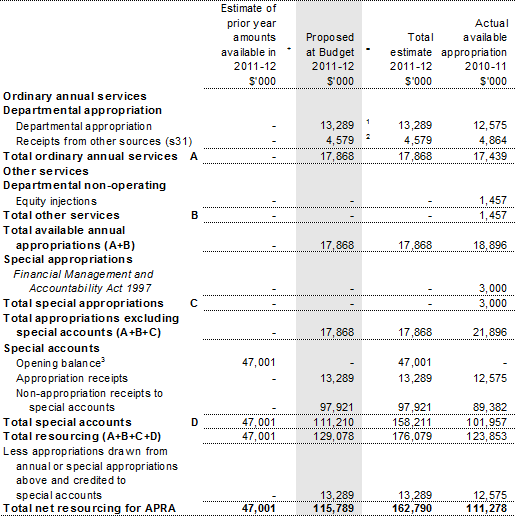
1. Appropriation Bill (No. 1) 2011-12.
2. Receipts received under section 31 of the Financial Management and Accountability Act 1997.
3. Estimated opening balance for special accounts (for further detail on special accounts see Table 3.1.2).
1.3 Budget measures
Budget measures relating to APRA are detailed in Budget Paper No. 2, Budget Measures 2011-12 and are summarised below.
Table 1.2: Australian Prudential Regulation Authority 2011-12 Budget measures
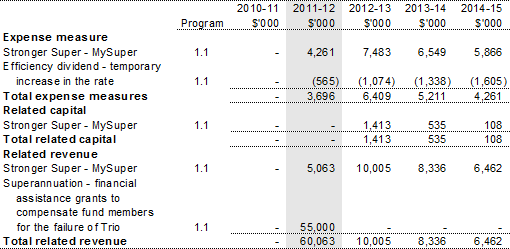
Prepared on a government finance statistics (fiscal) basis.
Section 2: Outcomes and planned performance
2.1 Outcomes and performance information
Government outcomes are the intended results, impacts or consequences of actions by the Government on the Australian community. Commonwealth programs are the primary vehicle by which government agencies achieve the intended results of their outcome statements. Agencies are required to identify the programs which contribute to Government outcomes over the budget and forward years.
APRA's outcome is described below, specifying the strategy, program objective, program deliverables and program key performance indicators used to assess and monitor the performance of APRA.
Outcome 1: Enhanced public confidence in Australia's financial institutions through a framework of prudential regulation which balances financial safety and efficiency, competition, contestability and competitive neutrality
Outcome 1 strategy
The role of APRA is developing and enforcing a robust prudential framework that promotes prudent behaviour by ADIs, insurance companies, superannuation funds and other financial institutions it supervises, with the key aim of protecting the interests of their depositors, policyholders and superannuation fund members.
Prudential regulation focuses on the quality of an institution's systems for identifying, measuring and managing the various risks in its business.
Outcome expense statement
Table 2.1 provides an overview of the total expenses for Outcome 1.
Table 2.1: Budgeted expenses for Outcome 1
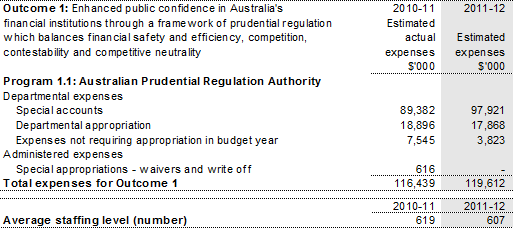
Contributions to Outcome 1
Program 1.1: Australian Prudential Regulation Authority
Program objective
To enhance public confidence in Australia's financial institutions through a framework of prudential regulation which balances financial safety and efficiency, competition, contestability and competitive neutrality.
Program expenses
Program expenses are currently estimated to peak in 201
1-12 as APRA maintains its more intensive supervisory and policy development activities. The forward estimates are reducing after 2011-12 due to the end of funding associated with the global financial crisis.
Table 2.2: Program expenses

Program deliverables
APRA has the following program deliverables:
- the issuance of prudential standards and guidance to assist regulated industries manage risk;
- active oversight of regulated institutions aimed at mitigating financial loss by depositors, policyholders and superannuation fund members which may result from the failure of a regulated institution to adequately manage risk; and
- advice to government on prudential regulation policy development; advice on amendments to legislation and regulations administered by APRA; and briefing to the government on matters emerging from international forums which may impact on prudential policy.
Program key performance indicators
APRA has the following key performance indicators:
- timely issuance of prudential standards and guidance which address risk management exposures of regulated institutions;
- identification of emerging prudential risks within regulated institutions through programs of on-site visits and off-site surveillance and the supervision of remedial actions to effectively manage such risks;
- exercise of APRA's formal enforcement powers where necessary to protect the interests of depositors, policyholders, superannuation fund members or the public interest generally; and
- timely briefings to government on financial system developments and on major items of policy interest emerging from APRA participation in international forums.
Section 3: Explanatory tables and budgeted financial statements
Section 3 presents explanatory tables and budgeted financial statements which provide a comprehensive snapshot of APRA's finances for the budget year 2011-12. It explains how budget plans are incorporated into the financial statements and provides further details of the reconciliation between appropriations and program expenses, movements in administered funds, special accounts and government Indigenous expenditure.
3.1 Explanatory tables
3.1.1 Movement of administered funds between years
APRA has not moved any administered funds between years.
3.1.2 Special accounts
Special accounts provide a means to set aside and record amounts used for specified purposes. Special accounts can be created by a Finance Minister's Determination under the Financial Management and Accountability Act 1997 or under separate enabling legislation. Table 3.1.2 shows the expected additions (receipts) and reductions (payments) for each account used by APRA.
Table 3.1.2: Estimates of special account cash flows and balances
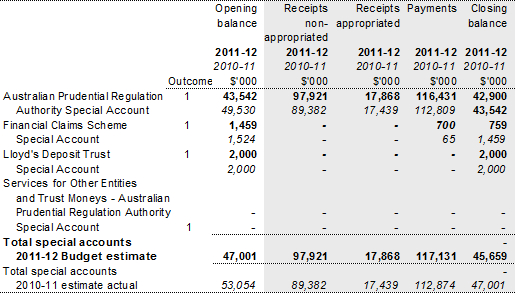
3.1.3 Australian Government Indigenous Expenditure
APRA does not have any Australian Government Indigenous Expenditure.
3.2 Budgeted financial statements
3.2.1 Differences in agency resourcing and financial statements
There are no material differences between the resource information presented in the Budget Papers and Portfolio Budget Statements and APRA's financial statements as a result of differences between Australian Accounting Standards and Government Finance Statistics.
In addition, APRA is not a party to related entity transactions that would result in significant differences between the resource information presented in the Budget Papers and Portfolio Budget Statements and APRA's financial statements.
3.2.2 Analysis of budgeted financial statements
The departmental comprehensive income statement (Table 3.2.1) shows a net increase in appropriation revenue from $102.5 million forecast for 2010-11 to $111.2 million in 2011-12. The $8.7 million increase mainly reflects:
- $4.2 million of new funding to support work associated with implementing the Stronger Super – MySuper measure (total funding of $26.2 million, including capital investment, is provided across the budget and forward estimates to 2014-15 inclusive);
- the use of $3.8 million of global financial crisis appropriation carried over from prior years;
- the receipt of $1.3 million of under-collected 2010-11 levies; and
- a reduction in funding of $0.6 million after applying the 2011-12 efficiency dividend.
Employee expenses of $84.1 million support a reduced average staffing level (ASL) of 607 (619 in 2010-11); consistent with the ongoing consolidation of institutions in the industries APRA regulates.
Supplier costs in 2011-12 take into account savings on Sydney leasing costs and reductions in technology, travel and property expenditures in line with whole-of-government requirements.
APRA is budgeting for an operating loss of $3.8 million in 2011-12, to be funded from accumulated surpluses.
The budgeted departmental balance sheet (Table 3.2.2) shows that, after funding the budgeted operating loss of $3.8 million in 2011-12, APRA will maintain sufficient financial assets to meet all known employee and supplier commitments as and when they fall due.
Non-financial asset balances will be unchanged at $18.3 million in 2011-12 and will remain stable over the forward estimates as APRA maintains its investments in core supervisory and corporate infrastructure.
Contributed equity remains unchanged over 2011-12, but will increase over the forward estimates by $2.1 million to support technology investment for Stronger Super – MySuper.
Retained surpluses, after funding the budgeted operating loss of $3.8 million in 2011-12, are set to maintain general reserves at a level sufficient to accommodate unforseen business needs which may arise from supervision of at-risk institutions.
The budgeted departmental statement of cash flows (Table 3.2.3) reflects the source and application of appropriations and other revenue, as detailed in Table 3.2.1.
Table 3.2.4 shows the expected change in equity from 2010-11 to 2011-12. The only change will be the use of accumulated surpluses to partially meet 2011-12 expenditures.
The departmental capital budget statement (Table 3.2.5) indicates APRA's capital needs will, apart from the Stronger Super – MySuper measure, be met by internally generated resources. The expected movements in fixed assets and intangibles between 2010-11 and 2011-12 are shown in Table 3.2.6.
The schedule of budgeted income and expenses administered on behalf of government (Table 3.2.7) shows the amounts APRA collects in supervisory levies from the finance industry on behalf of the Government under the Financial Institutions Supervisory Levies Collection Act 1998. Apart from the amount required to fund APRA, the levies also include amounts to fund the activities of the Australian Taxation Office (ATO) for unclaimed moneys and lost member functions and the Australian Securities and Investments Commission (ASIC) for consumer protection and market integrity functions. The expenses are an estimate of levies and penalties that will be waived or written off in the year.
In addition, a $55 million levy will be collected in 2011-12 from the superannuation industry under the Superannuation (Financial Assistance Funding) Levy Act 1993, to recover costs associated with financial assistance provided to certain superannuation fund members under Part 23 of the Superannuation Industry (Supervision) Act 1993.
The schedule of budgeted assets and liabilities administered on behalf of Government (Table 3.2.8) mainly reflects the unused funds relating to the Financial Claims Scheme.
A
s indicated in the schedule of budgeted administered cash flows (Table 3.2.9), the cash collected is swept daily from the APRA account to the Official Public Account (OPA), from which APRA, in turn, draws down the amounts appropriated to it by the Parliament (as per Table 3.2.1). The residual is retained in the OPA to meet Treasurer's Determinations for the ATO and ASIC and recoupment of financial assistance made to the superannuation industry.
3.2.3 Budgeted financial statements tables
Table 3.2.1: Budgeted departmental comprehensive income statement
(for the period ended 30 June)
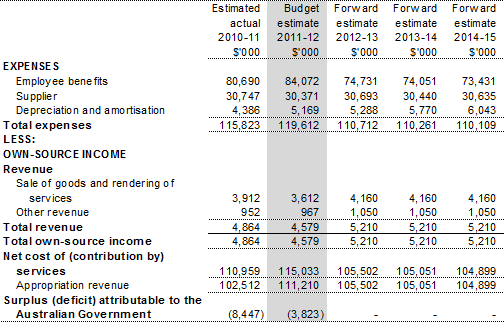
Prepared on Australian Accounting Standards basis.
Table 3.2.2: Budgeted departmental balance sheet
(as at 30 June)
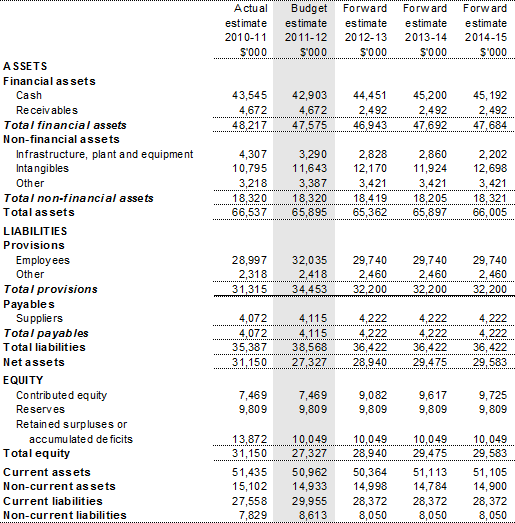
Prepared on Australian Accounting Standards basis.
Table 3.2.3: Budgeted departmental statement of cash flows
(for the period ended 30 June)
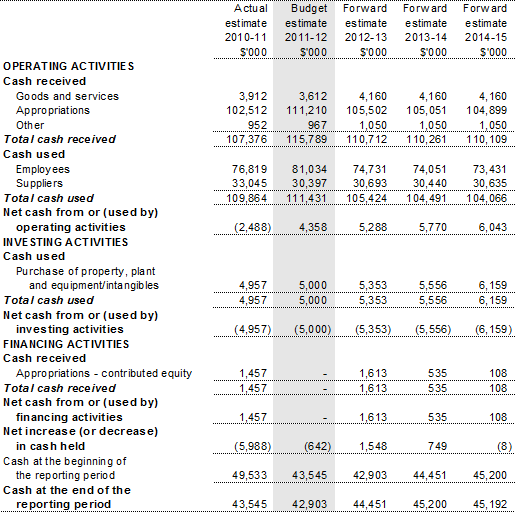
Prepared on Australian Accounting Standards basis.
Table 3.2.4: Departmental statement of changes in equity — summary of movement
(budget year 2011-12)
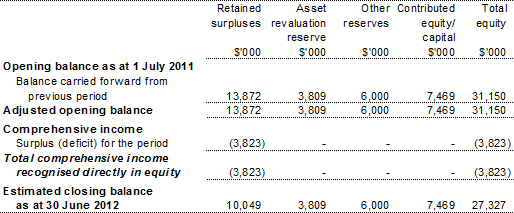
Prepared on Australian Accounting Standards basis.
Table 3.2.5: Departmental capital budget (DCB) statement
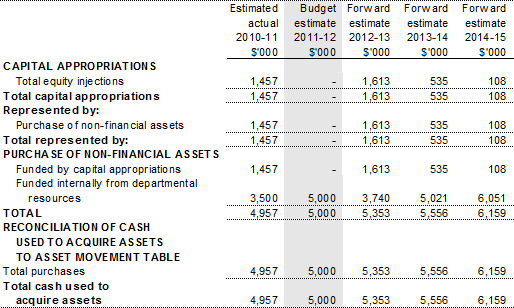
Prepared on Australian Accounting Standards basis.
Table 3.2.6: Statement of asset movements — departmental
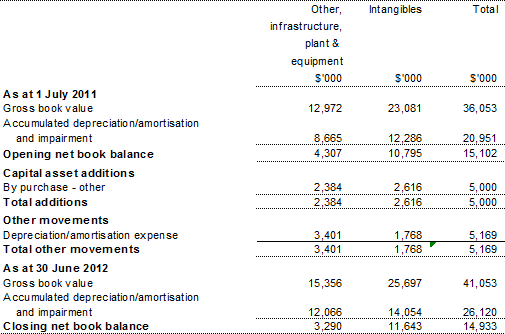
Prepared on Australian Accounting Standards basis.
Table 3.2.7: Schedule of budgeted income and expenses administered on behalf of
government (for the period ended 30 June)
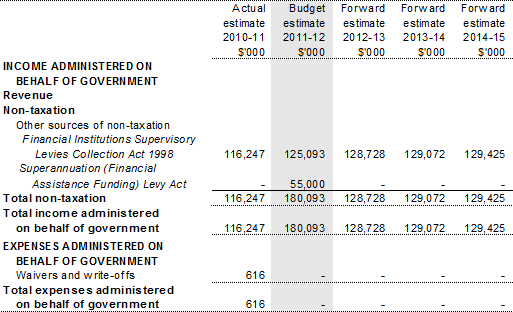
Prepared on Australian Accounting Standards basis.
Table 3.2.8: Schedule of budgeted assets and liabilities administered on behalf of
government (as at 30 June)
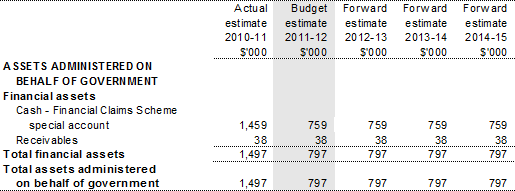
Prepared on Australian Accounting Standards basis.
Table 3.2.9: Schedule of budgeted administered cash flows
(for the period ended 30 June)
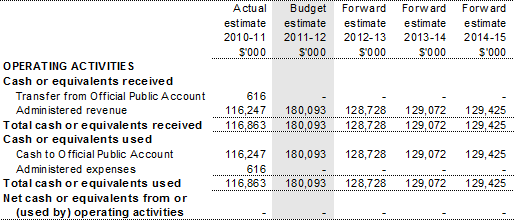
Prepared on Australian Accounting Standards basis.
3.2.4 Notes to the financial statements
Basis of accounting
The financial statements have been prepared on an accrual basis in accordance with historical cost convention.
Budgeted departmental statement of financial performance
Revenues from Government
APRA is funded by appropriation to its special account for levies and late payment penalties collected under the Financial Institutions Supervisory Levies Collection Act 1998. The revenue reported by APRA is net of the levies retained in the Official Public Account to fund ASIC for consumer protection and market integrity functions, and the ATO for unclaimed moneys and lost member functions.
Other revenue
Revenue from rendering of specific services is recognised by reference to the stage of completion of contracts or other agreements. Revenue from licence fees is recognised on receipt of the application and licence fee.
Depreciation and amortisation
APRA's depreciation expense remains in balance with the capital program aimed at maintaining APRA's processes and infrastructure to an appropriate standard.
Budgeted departmental statement of financial position
Financial assets
Receivables include levies invoiced but still outstanding at the financial year-end and accrued revenues, being fees prorated over the periods to which they relate.
All accounts receivable are recorded at their estimated recoverable amount.
Non-financial assets
Non-financial assets include leasehold improvements, furniture and fittings, computer hardware and office equipment. All of the foregoing assets are shown at fair value. Intangible assets comprise capitalised software, including works in progress and are shown at cost. APRA does not own any land or buildings.
Other non-financial assets include prepayments.
Provisions and payables
Provisions and payables represent liabilities for miscellaneous accruals and employee benefits, including accrued salary and leave entitlements, provisions for making good leased premises and payments to trade creditors.
Equity
The opening balance of contributed equity includes the net value of assets and liabilities transferred from the Reserve Bank of Australia and the Insurance and Superannuation Commission on the formation of APRA on 1 July 1998, less an amount of $2.1 million returned to the Consolidated Revenue Fund as a return of unused appropriation in 2004-05.
Budgeted departmental statement of cash flows
Cash received from operating activities includes the appropriation for levies collected from industry less amounts collected on behalf of the ATO and ASIC and cash from fees and charges.
Schedule of budgeted revenues and expenses administered on behalf of Government
Revenues
The other non-taxation revenues are the levies and late payment penalties collected under the Financial Institutions Supervisory Levies Collection Act 1998. The revenue reported in this statement is higher than that reported by APRA in the budgeted agency statement of financial position by the amount retained in the Official Public Account to fund ASIC and ATO activities described above.
Write down and impairment of assets
Write down and impairment of assets represents waivers and write-offs of levies.
Schedule of budgeted assets and liabilities administered on behalf of Government
Financial assets
The financial assets include levy debt invoiced and still outstanding at year-end.
Schedule of budgeted administered cash flows
All cash collected by APRA for levies, late lodgement and late payment penalties under the Financial Institutions Supervisory Levies Collection Act 1998 is transferred to the Official Public Account at the close of business each day.